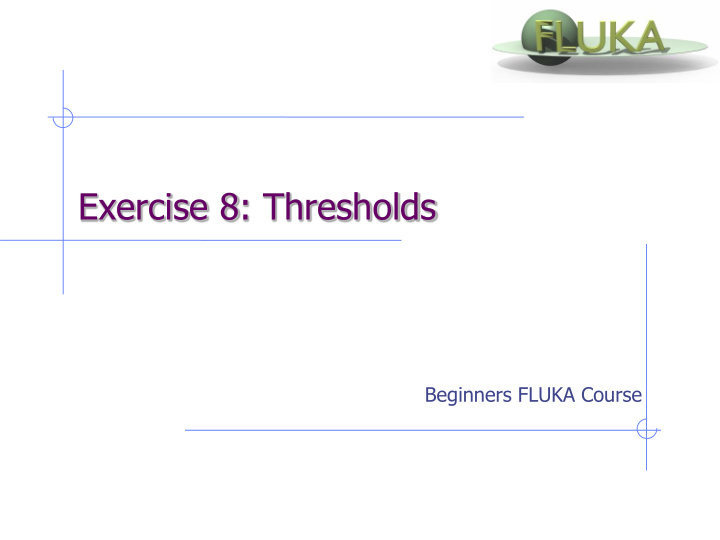



Exercise 8: Thresholds Beginners FLUKA Course
Exercise 8: Thresholds First part Aim: “see” the effect of different threshold settings Easier with thin layers and with interfaces between strongly different materials change the layout Observables: Dose deposition Fluence of backscattered electrons Practice also with preprocessor directives in the input file
Exercise 8: Thresholds Instructions: changes to the geometry/beam Create a folder called ex8, download the solution of ex5 (only ex5.inp) from the website, rename it to ex8.inp and open it in flair Change the beam into 10 MeV electrons beam (hint: use #define PROTON) Change the beam size to a circular one with 2 mm radius Change the target 3 layers thickness to 50 microns each Change the target radius to 5 mm Change the surrounding air into Vacuum Change the materials of the region TARGS2 to Lead. Change the material of region TARGS3 to Aluminum (i.e.: target is made of H 2 O – Pb – Al)
Exercise 8: Thresholds Instructions : general settings thin layers and low thresholds need for high tracking precision set PRECISIO as default Switch on single scattering at boundaries (find how..) Instructions: prepare a set of different thresholds, using “#define” Define 3 preprocessor variables, e.g.: HI-THR , LOW-THR, VLOW-THR Use EMFCUT and DELTARAY cards to set threshold in all materials: #if HI-THR Electrons: 1 MeV kinetic energy Photons: 5 keV #elif LOW-THR Electrons: energy corresponding to a range ≈ ½ of the Pb thickness Photons: 5 KeV #elif VLOW-THR Electrons: energy corresponding to a range ≈ z bin size, in Pb Photons: 5 keV #endif SAME energy thresholds in all materials! HINT: go to http://physics.nist.gov/PhysRefData/Star/Text/contents.html
Exercise 8: Thresholds Instructions : scoring Remove old scorings One USRBIN scoring DOSE over the target: 1 micron bins along z, 5 microns bins in the radial direction One USRBDX to score fluence of electrons and positrons EXITING from the target first layer BACK into vacuum; one single linear bin in angle, linear binning in energy. Instructions: running in the RUN window of Flair click on the + button in the Run/Input frame choose a name for the first threshold option , i.e. ex8_hi-thr select the correct directive in the “Defines” frame run 5 runs , 100000 primaries each repeat for the other thresholds defined
Exercise 8: Thresholds Instruction: looking at the results PLOT for each threshold 1-d projection along z of the dose try to set the same y-scale for the three plots (set yscale [xx : yy] in the gnuplot options) compare the results for the 3 thresholds the usrbdx output (try to put all three on the same plot)
Exercise 8: Solution - settings Results “low threshold” Pb = 2.8 10 -2 g/cm 2 100 keV 25 very-low threshold Pb = 1.1 10 -3 g/cm 2 10 keV 1 (or 12, but we choose a round number for ease) to be set: EMFCUT with PROD-CUT (set production threshold) EMFCUT with BLANK (set transport threshold) DELTARAY ( in case we run protons later..) Warning: to set KINETIC energy in EMFCUT the WHAT(1) value must be NEGATIVE, otherwise it sets the TOTAL energy
Exercise 8: Solution - electrons High threshold Low threshold Very low threshold
Exercise 8: Solution - electrons
Exercise 8: Solution - backscattering Energy [GeV]
Exercise 8: Thresholds Second part, protons! Aim : learn more about thresholds and getting familiar with DPA (Displacement Per Atom) Instructions: settings Change the BEAM to 4 MeV protons (#define PROTON) For HI-THR, LOW-THR, and VLOW-THR cases, set proton threshold at 10 MeV, 100 keV, and 1 KeV respectively Add MAT-PROP cards specifying a DPA-ENERergy threshold of 25 eV for lead and 27 eV for aluminum
Exercise 8: Thresholds Second part, protons! Instructions: results Add one single USRBIN grid (having 50 bins in radius, 1 bin in Φ , and 100 bins in Z) on the aluminum and lead targets scoring DPA-SCO and NIEL-DEP (Non Ionizing Energy Loss) “with a suitable resolution” (it depends on the beam size) Question: why not scoring on water? Evaluate the average number of Displacements Per Atom (DPA) for a 100 day long beam time and 1 A proton current Plot the dose deposition (HI-THR and LOW-THR only) and see the difference; can you see and explain the effect of the different tresholds?
Exercise 8: Solution – proton beam High threshold Low threshold
Recommend
More recommend